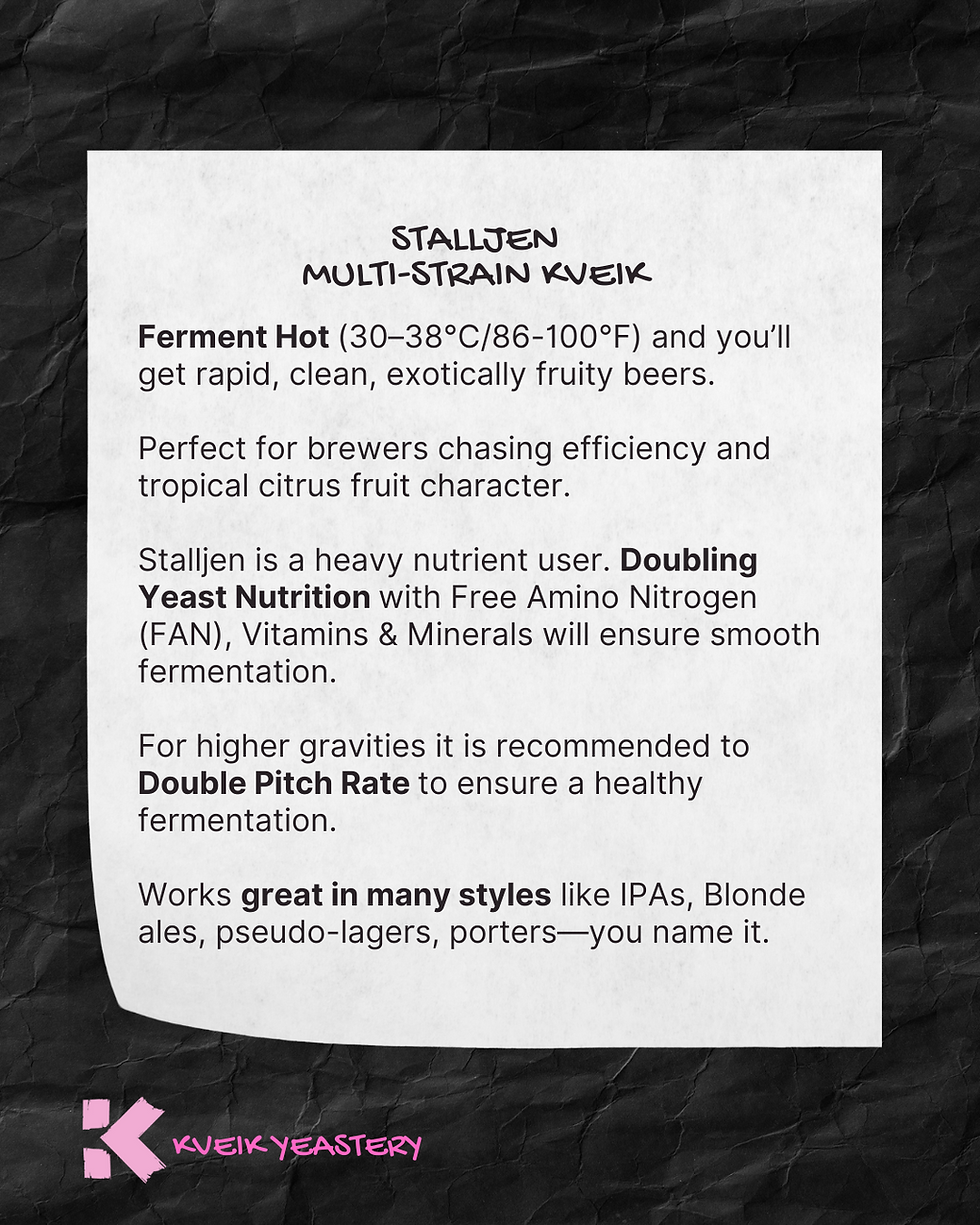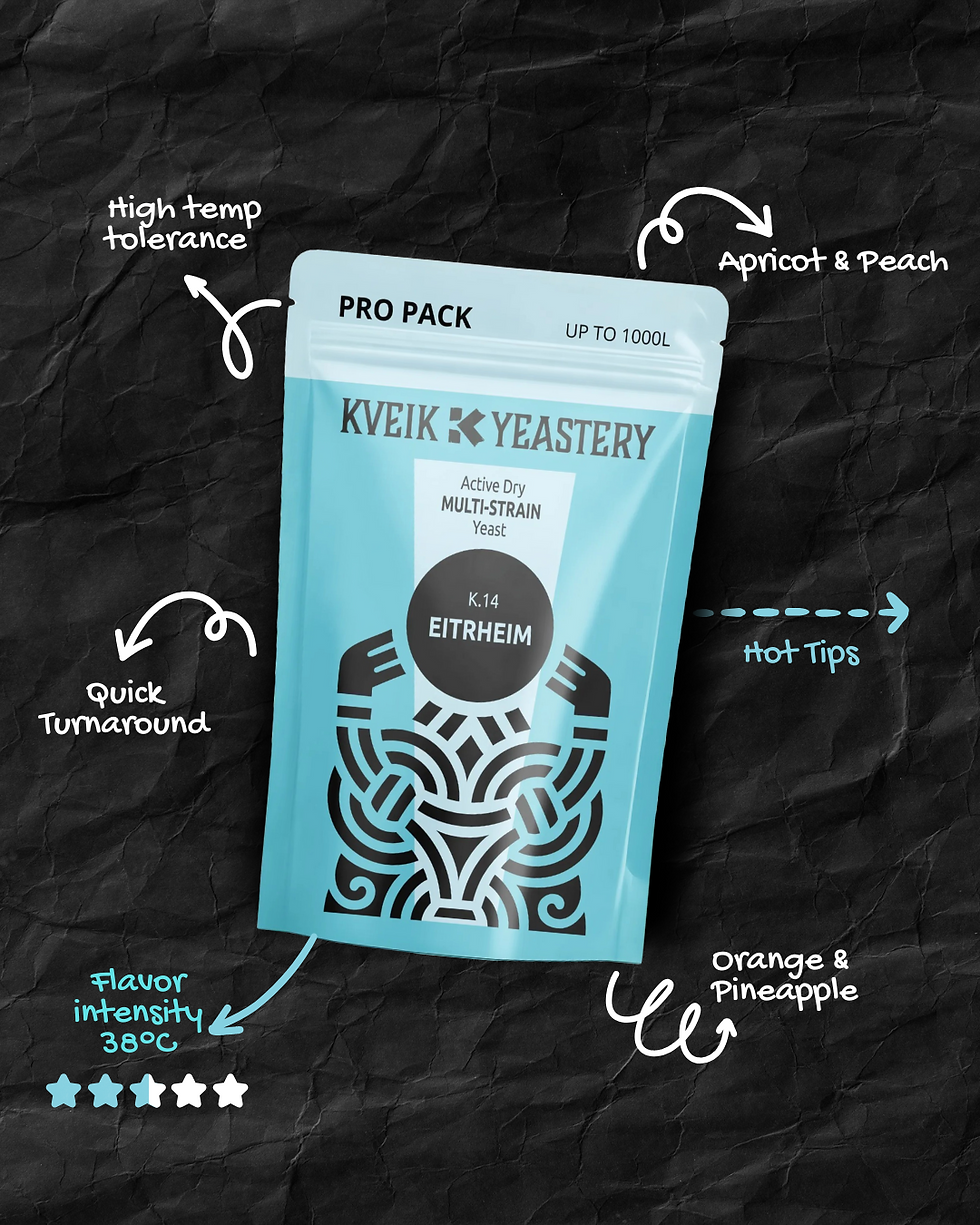Temperature Tolerance for Your Summer Brews with Multi-strain Kveik
- lch020
- Jul 7
- 3 min read
For many brewers, summer brewing brings a predictable challenge: maintaining fermentation stability in rising ambient temperatures. Standard brewing strains—like Saccharomyces cerevisiae and Saccharomyces pastorianus—have relatively defined temperature windows. Push them too far, and you risk stalling, off-flavors, or outright fermentation failure.
But not all yeasts respond to heat the same way. Multi-strain Kveik cultures present an alternative. Their thermotolerance isn’t just anecdotal—it’s backed by their biological structure and behavior.
What Happens When Yeast Overheats?
Temperature affects yeast metabolism at every level. Higher temperatures increase enzyme activity, which in turn accelerates metabolic reactions. Initially, this seems beneficial—faster fermentation, higher alcohol output. But it quickly becomes counterproductive. More alcohol and more reactive oxygen species (ROS) lead to cellular stress. Membrane integrity breaks down. DNA and proteins degrade. Metabolism becomes unstable, producing by-products like fusel alcohols and diketones.
Why Multi-Strain Kveik Stays Stable
Multi-strain Kveik (MSK) cultures show unusually high tolerance to thermal stress. Two key biological mechanisms set them apart:
1. Heat Shock Proteins (HSPs)
Yeast cells under heat stress activate a set of proteins called Heat Shock Proteins. These molecular chaperones (like HSP104 and HSP82) repair damaged enzymes and assist in protein folding. In Kveik cultures, these proteins are more actively expressed under stress, giving the cells a better ability to recover and maintain functionality.
2. Trehalose Accumulation
Kveik yeasts also produce higher levels of trehalose—a sugar that acts as both an energy reserve and a stress protectant. This compound stabilizes membranes and proteins, helping cells survive high alcohol concentrations, dehydration, and both hot and cold conditions. The elevated trehalose levels in Kveik are likely due to enhanced TSP1/2 gene activity.

Multi-Strain Advantage
Unlike single-strain cultures, MSKs bring diversity to the fermentation tank. Different strains contribute different strengths—some handle sugar uptake and alcohol conversion more efficiently, others focus on ester production and aroma. This division of labor allows for better performance across variable conditions, including temperature spikes.
If you're brewing through the summer and struggling with temperature control, Multi-strain Kveik cultures offer a practical, biologically backed solution. Their stress-response systems and genetic traits make them particularly resilient under heat—without compromising fermentation performance or flavor outcomes.
Customer Story: Trysil Bryggeri’s Summer-Ready IPA
Trysil Bryggeri, nestled in Trysil (Innlandet, Norway), crafts Trysilkyss IPA — a creamy, fruity 7 % ABV double IPA featuring fresh citrus, passion fruit, and soft pine notes. They chose K.9 Ebbegarden, a multi-strain kveik from Stordal and fermented at 35°C, finishing fermentation in just a few days. This strain brings forward clean apple and pear esters, with hints of citrus and tropical fruit — a flavour profile that enhances Trysilkyss's hop-forward character.

Thanks to K.9 Ebbegarden, Trysil Bryggeri achieves consistent fermentation in ambient summer temps (30–35 °C), reducing the need for cooling and accelerating tank turnaround.
K.22 Stalljen multis-strain
K.22 Stalljen, from Hornindal, stands out for its extended range—it ferments cleanly from 12 °C up to 38 °C—so it can be used for pseudo-lagers or hop-forward ales. It offers tropical fruit flavors dominated by mango and pineapple, with subtle citrus undertones. This makes Stalljen suitable across styles—from fruited lagers to Hazy IPAs at 32 °C—offering flexibility in breweries without strict cooling.


K.14 Eitrheim multi-strain
From Tokheim, K.14 Eitrheim also operates well in the 15–38 °C range, particularly at 31–35 °C, where it completes fermentation in roughly 72 hours. It expresses vibrant stone-fruit notes—apricot and peach—along with hints of orange and pineapple. Eitrheim is well suited to IPAs, Pale Ales, and NEIPAs, adding juicy complexity in beers fermented at summer temperatures.


K.9 Ebbegarden multi-strain
K.9 Ebbegarden originates from Stordal farm and thrives in the 15–38 °C range, fermenting faster as temperatures rise—typically completing within 72 hours at 31–35 °C. Its flavor profile centers on apple and pear, with underlying tropical fruit and citrus notes—delicate yet complex. It’s ideally used in IPAs or Pale Ales, bringing a crisp fruitiness that complements hop-forward beers while standing up well to summer high temps.


K.1 Voss multi-strain
K.1 Voss is a multi-strain kveik directly from Voss, Norway. It ferments robustly between 15 °C and 40 °C, with optimal performance at 31–35 °C—ideal for hot summer conditions. The yeast delivers a layered citrus profile—orange, tangerine, and juicy tropical notes—with mild spice on the finish . It's a versatile strain suited to Pale Ales, IPAs, Farmhouse styles, and even kettle-soured fruited beers. At 20 °C, brewers can expect a clean, neutral Blonde Ale; bump up to 28–35 °C, and you’ll get hazy pales or West Coast-style IPAs with a clean, dry finish; even at 40 °C, Voss handles the heat cleanly in fruited sour batches.








Comments